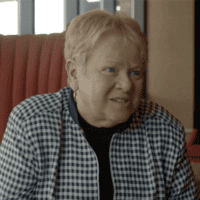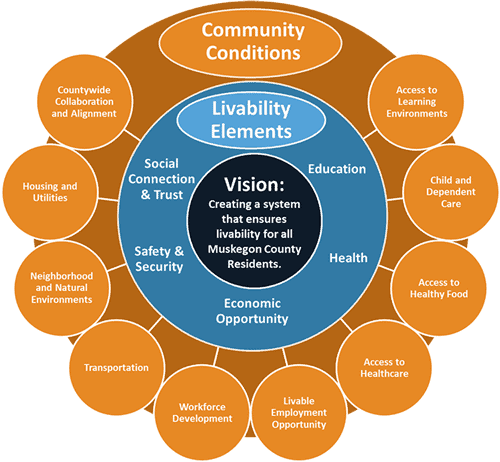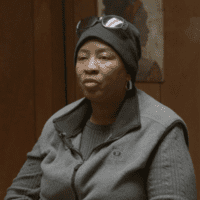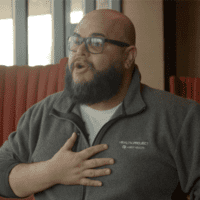The Muskegon community is in the midst of a cultural renaissance
Exactly one year ago, residents across the county came together to understand — and address — the root causes that affect public health. They created their very own Livability Lab, a vibrant environment designed to bring together diverse perspectives and empower these individuals with the freedom to experiment. The lab focused on accelerating bold action, fostering innovative engagement, democratizing decision making, transforming longstanding attitudes, changing systems, engaging in authentic storytelling, addressing racial inequalities and improving livability.

"We knew that you got to get the work of people being healthy out of healthcare alone and into other systems."
— Mary McDonald, Director of the Muskegon CHIR
"We knew that you got to get the work of people being healthy out of healthcare alone and into other systems."
— Mary McDonald, Director of the Muskegon CHIR
Together, 19 teams — comprising local residents, businesses and stakeholders — agreed to tackle these core community issues through the 100-day Challenge. Using findings from community surveys, focus groups, reports and countless community visioning sessions, the group settled on an audacious vision: creating a system that ensures livability for all Muskegon County residents. This vision was supported by five livability elements:
- Social connection and trust
- Safety and security
- Economic opportunity
- Health
- Education

The Muskegon Livability framework summarizes the community’s goals for creating a system that ensures livability for all Muskegon County residents. The livability elements (blue) represent what people need to thrive and prosper in Muskegon County. The community conditions (orange) represent what needs to be in place across the county to promote the livability elements and achieve the vision.

“Our community is struggling. In order to make change, you have to have more of the people in the community to care. It’s for them. Without them telling us what they need, we don’t know what to do.”
— Joyce Starr, Pastor at Harvest Time
“Our community is struggling. In order to make change, you have to have more of the people in the community to care. It’s for them. Without them telling us what they need, we don’t know what to do.”
— Joyce Starr, Pastor at Harvest Time
When launch day arrived on September 10, 2019, a diverse mix of more than 300 people from across the county attended. Public Sector Consultants’ work, made possible by a grant from the Michigan Department of Health and Human Services, followed the group as they hit — and missed — milestones along the way. We produced a first-person narrative video to help tell the story of Muskegon’s grassroots work and aspirations for an inclusive, accessible and livable community. This video also showcases the Livability Lab’s impact, highlighting residents’ diverse perspectives on how support from Michigan’s State Innovation Model accelerated its work to improve the quality of life for everyone in Muskegon County. We also caught up with Livability Lab participants to find out what they learned through the process and what they are working on now.

“We had 300 people come out at 7:30 in the morning on a wet and cold day ... because they had the chance to have their voice heard.”
— Michael Ramsey, Muskegon County Resident and Program Implementation Coordinator at Mercy Health
“We had 300 people come out at 7:30 in the morning on a wet and cold day ... because they had the chance to have their voice heard.”
— Michael Ramsey, Muskegon County Resident and Program Implementation Coordinator at Mercy Health
A closer look
We sat down with Livability Lab design team members Kerri VanderHoff and Vondie Woodbury to find out more about their process and the immense amount of work it took to pull off a successful 100-day Challenge and keep the momentum going.
Where did you get the idea of doing the 100-day Challenge? Why did it make sense for the Muskegon CHIR?
We had active engagement from residents through initiatives, including surveys, community meetings and Photovoice, and were seeking ways to better connect the residents with various organizations in order to partake in community-wide decision-making processes. Pennie Foster-Fishman, Michigan State University, came up with the idea of the challenge. While the 100-day Challenge process has been used around the country, it usually has a specific focus; for example, improving high-school graduation rates. As we worked through the feedback, it became clear that the people of Muskegon County weren’t going to settle for a goal that narrow. Understanding that things are interconnected, residents knew that to improve livability, it’s necessary to think big. Business, education, neighborhoods, health and more all needed to be included in this effort. This is a groundbreaking approach.
Tell us about the core team involved in launching the Livability Lab.
The core team represented a cross section of key community leaders in positions to direct resources and influence policy change and residents who were — or wanted to be — active in the community. The buy-in of these individuals was important if we were to generate the type of cross-sector Livability Lab participation that we wanted. While we developed data, the agenda and other elements of the day, we relied upon these leaders for their input and recommendations before any finalization. They really took a major role in this framing. In this way, they were able to take ownership of the process.
We also used their feedback to help us visualize how to sustain the lab past the end of CHIR funding. Did they experience value? Were we hitting the issues that we would never solve without cross-sector discussion? Was this something that our community needed to continue to help us move ahead? We learned through this process that these sectors share many common problems. But, too often, they tried to address them within the confines of their specific sector. By helping them see that these problems emerge across sectors, the ability to get everyone on a common path became easier.
What would you say are the biggest accomplishments of the 100-day Challenge?
Zone work, data collection and social determinants of health leading to a seamless referral process … overall the takeaway from participants was a positive experience and recognition that the cross-sector involvement brought over 300 people together in a room — people who may not ordinarily cross paths. This combination sparked innovation and enthusiasm for moving forward together. We made this infographic representing participant feedback.
What are social determinants of health?
Social determinants of health are conditions in the places where people live, learn, work and play that affect a wide range of health risks and outcomes. The Centers for Disease Control and Prevention’s Healthy People 2020 uses a place-based framework that outlines five key areas of these determinants: health and healthcare, education, social and community context, economic stability and neighborhood and built environment.
What advice would you give to other communities that want to model a similar community development approach?
Make the vision aspirational and reflective of community input. We conducted months of surveys and interviews. Identify root causes that are barriers to the vision and encourage individual team goals to focus on tackling one of those barriers in a manageable action plan that is challenging but not overwhelming. In Muskegon County, we focused the aspirational message on resilience, love, pride of place, finding bright lights, leveraging strengths and building a community legacy of livability. Democratize the process. Set clear benchmarks early on.
You are one year out from the official kickoff of the 100-day Challenge. Looking back, would you change anything about the process?
We’d go back even further and would have started with Livability Lab earlier in the CHIR timeline. Knitting together voices that aren’t typically in the room (from a variety of sectors) and including residents that are not always invited to the table or are often intimidated by the process was critical. We wanted to even out the voices in our community; for example, the chamber of commerce was in the room just as the neighborhood associations were in the room. It’s a very important part of getting to the root causes.
When taking on an audacious goal like this, you are bound to learn a thing or two along the way. What sticks out to you from this experience?
Beyond the data, people need to look at root cause analysis — extend that over time to see what we could do that would be a measurable response to what we’ve found. There’s a piece of this problem that everybody owns. That’s why the cross-sector piece is so important because everybody owns a piece of the solution. A program isn’t the answer for everything. We also learned that when you embrace and respect people’s lived experience as valuable knowledge to be considered in decision making, amazing things can happen.
The novel coronavirus (COVID-19) has impacted local communities in many ways. The Livability Lab team recently resurveyed Muskegon residents who are living — and sometimes struggling — through this health crisis. What did you find?
COVID-19 has exacerbated the disparities we have already been seeing.
We created a short video interviewing the Livability Lab core team regarding past, present and future. It played as part of the Livability Lab 2.0 launch on August 10, 2020.
What’s next for Muskegon County?
We are currently on a 45-day challenge with Livability Lab 2.0. Current funding ends in September, but community enthusiasm encourages us to seek ways to continue this important work.

“My vision is to kind of step back and go back to grassroots organizing. Getting people back out of their house and knowing who their neighbors are, understanding their struggles.”
— Marquis Childers, Community Outreach Coordinator for the Muskegon CHIR
“My vision is to kind of step back and go back to grassroots organizing. Getting people back out of their house and knowing who their neighbors are, understanding their struggles.”
— Marquis Childers, Community Outreach Coordinator for the Muskegon CHIR
Thank you to the MDHHS for supporting this video production and the Muskegon CHIR’s efforts. We tip our hat to the 19 Livability Lab teams, coaches and residents who devoted their time and energy to creating solutions that benefit all Muskegon County residents. While we know you’re just getting started, it’s inspiring to see what can be achieved when a community organizes around a cause worth fighting for.
Thank you to the MDHHS for supporting this video production and the Muskegon CHIR’s efforts. We tip our hat to the 19 Livability Lab teams, coaches and residents who devoted their time and energy to creating solutions that benefit all Muskegon County residents. While we know you’re just getting started, it’s inspiring to see what can be achieved when a community organizes around a cause worth fighting for.


